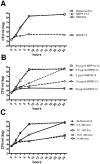Myeloid-related protein-14 contributes to protective immunity in gram-negative pneumonia derived sepsis
- PMID: 23133376
- PMCID: PMC3486918
- DOI: 10.1371/journal.ppat.1002987
Myeloid-related protein-14 contributes to protective immunity in gram-negative pneumonia derived sepsis
Abstract
Klebsiella (K.) pneumoniae is a common cause of pneumonia-derived sepsis. Myeloid related protein 8 (MRP8, S100A8) and MRP14 (S100A9) are the most abundant cytoplasmic proteins in neutrophils. They can form MRP8/14 heterodimers that are released upon cell stress stimuli. MRP8/14 reportedly exerts antimicrobial activity, but in acute fulminant sepsis models MRP8/14 has been found to contribute to organ damage and death. We here determined the role of MRP8/14 in K. pneumoniae sepsis originating from the lungs, using an established model characterized by gradual growth of bacteria with subsequent dissemination. Infection resulted in gradually increasing MRP8/14 levels in lungs and plasma. Mrp14 deficient (mrp14(-/-)) mice, unable to form MRP8/14 heterodimers, showed enhanced bacterial dissemination accompanied by increased organ damage and a reduced survival. Mrp14(-/-) macrophages were reduced in their capacity to phagocytose Klebsiella. In addition, recombinant MRP8/14 heterodimers, but not MRP8 or MRP14 alone, prevented growth of Klebsiella in vitro through chelation of divalent cations. Neutrophil extracellular traps (NETs) prepared from wildtype but not from mrp14(-/-) neutrophils inhibited Klebsiella growth; in accordance, the capacity of human NETs to kill Klebsiella was strongly impaired by an anti-MRP14 antibody or the addition of zinc. These results identify MRP8/14 as key player in protective innate immunity during Klebsiella pneumonia.
Conflict of interest statement
The authors have declared that no competing interests exist.
Figures









References
-
- Kollef MH, Kollef KE (2005) Antibiotic utilization and outcomes for patients with clinically suspected ventilator-associated pneumonia and negative quantitative BAL culture results. Chest 128: 2706–2713. - PubMed
-
- Kang CI, Song JH, Chung DR, Peck KR, Ko KS, et al. (2011) Risk factors and pathogenic significance of severe sepsis and septic shock in 2286 patients with gram-negative bacteremia. J Infect 62: 26–33. - PubMed
-
- Shorr AF, Tabak YP, Killian AD, Gupta V, Liu LZ, et al. (2006) Healthcare-associated bloodstream infection: A distinct entity? Insights from a large U.S. database. Crit Care Med 34: 2588–2595. - PubMed
-
- Giamarellou H (2005) Multidrug resistance in Gram-negative bacteria that produce extended-spectrum beta-lactamases (ESBLs). Clin Microbiol Infect 11 Suppl 4: 1–16. - PubMed
Publication types
MeSH terms
Substances
LinkOut - more resources
Full Text Sources
Medical
Molecular Biology Databases
Miscellaneous

